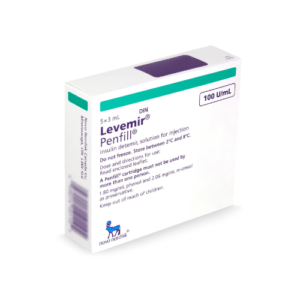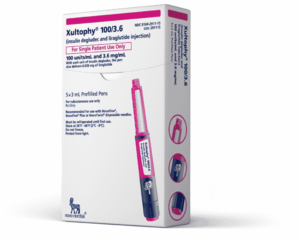Lantus Glargine Insulin Vial
(See the original document here)
Glargine insulin is a long-acting human insulin produced with DNA technology utilizing a non-pathogenic laboratory strain of Escherichia coli (K12). It is a clear and colorless liquid for subcutaneous use. It is made available in two forms and strengths:
– 10 mL multiple-dose Lantus Glargine Insulin Vial
– 3 mL single-patient use Lantus Solostar pen.
It is also available in 3.0 ml Lantus Cartridges form.
This medicine is generally prescribed for adults to treat type 2 diabetes (adults) and type 1 diabetes adults and pediatric patients (children six years and older), along with proper diabetic diet, exercise, and weight management.
Lantus Glargine Insulin Vial contains Lantus insulin, a brand name of glargine insulin, a long-acting insulin analog. Its absorption, distribution, and metabolism in the body are very similar to naturally occurring human insulin produced in people who do not have diabetes.
What is vial of Lantus 100 unit ml solution used for?
Medications Lantus controls high blood sugar levels in treating adults with type 2 diabetes. It is also prescribed for adults and children (6 years and older) with type 1 diabetes who require long-acting insulin. It supplies a slow, consistent release of insulin all day to help regulate your blood sugar levels between meals and overnight.
Your treatment may also require the support of fast-acting mealtime insulin to help control blood sugar spikes during meals. Lantus is typically used as a once-daily, self-administered injection. It is not used for the treatment of diabetic ketoacidosis (DKA).
How does Lantus Glargine Insulin Vial work?
Lantus works by simulating the action of naturally occurring insulin, which typically controls blood sugar levels in the body. The primary function of insulin (including insulin glargine, the kind used in Lantus) is the regulation of sugar metabolism. It lowers blood sugar levels by stimulating blood sugar absorption from the blood into skeletal muscle and fat cells and by blocking sugar production by the liver.
Studies in adults have shown that glargine insulin and naturally occurring human insulin have the same effectiveness and ability to lower blood sugar levels. However, compared with NPH human insulin, subcutaneously injected glargine insulin has a slightly slower onset and a longer duration of action. This is because of the micro-crystals in its formulation that slowly release the insulin, giving a long period of action of 18 to 26 hours, with a relatively steady effect profile and a small peak of action.
Lantus Glargine Insulin Vial Serious Side Effects
Common adverse effects of Lantus Glargine may include:
- Hypoglycemia (low blood sugar)
Other adverse effects of Lantus Glargine may include:
- Hyperglycemia
- Diabetic ketoacidosis (DKA)
- Injection site reactions
Hypoglycemia, otherwise known as low blood sugar, is one of the most common side effects experienced by insulin users. It can develop because of stress, illness, taking too much insulin, skipping or forgetting meals, increased exercise, using a new type of insulin, and taking other medication, including prescriptions, over-the-counter medicines, herbs, vitamins, and street drugs.
Signs of severe hypoglycemia can include
- disorientation
- convulsions
- loss of consciousness
On the other hand, hyperglycemia (high blood sugar) may develop if your body has too little insulin.
Symptoms of hyperglycemia may include
- confusion
- drowsiness
- nausea
- increased thirst
- decreased appetite
- vomiting
- flushed dry skin
- quickened heart rate
- increased urination
- dehydration
- blurred vision
- a fruity breath odour.
If left untreated, hyperglycemia can progress into diabetic ketoacidosis (DKA), resulting in unconsciousness and death.
Diabetic ketoacidosis (DKA) can develop from poorly controlled or uncontrolled type diabetes. It occurs when your body does not have enough insulin, which can happen if you miss your lantus dose, take a smaller quantity, overeat, or develop an infection or fever.
Symptoms of DKA come on gradually and may include
- thirst
- flushed face
- feeling drowsy
- loss of appetite.
If you have a rapid pulse with heavy breathing, that may signify a more severe condition. If left untreated, loss of consciousness, coma or even death can result. Get medical assistance immediately if you think you may be experiencing any of these symptoms.
Possible reactions on the skin at the injection site can include lipoatrophy, the localized loss of fat around the injection site that can look like depression in the skin, and lipohypertrophy, which is the accumulation of extra fat at the injection site, which may look like a small lump. Other localized skin reactions may include swelling, itching, and redness at the injection site.
How to take Lantus Glargine Insulin?
Lantus Glargine Insulin Vial is taken as a subcutaneous injection, and the injection sites within each injection area (abdomen, thigh, buttock, or deltoid) must be changed from one injection to the next. After injection, the area must not be massaged or rubbed. Speak to your doctor if you are unsure how to use this medication.

Lantus Glargine Insulin Vial should only be used if the solution is clear and colorless, with no particles or clumps visible. It is a clear solution, not a suspension like a few other insulin products.
What is dosage of Lantus Glargine Insulin?
Many factors can affect your usual Lantus dose, which includes changes in your diet, activity level, or work schedule. Other factors affecting your Lantus dose are illness, pregnancy, medication, exercise, and travel.
Lantus Glargine Insulin Vial is taken subcutaneously, once a day, at any time during the day, as long as it is taken at the same time every day.
If you have type 2 diabetes but have not been prescribed insulin before, you may be started at a dose of 10 U once daily and then have your dose subsequently adjusted according to your insulin needs. If you are changing over to Lantus from treatment with another intermediate or long-acting insulin, the amount and timing of that previous dose may need to be adjusted to avoid the risk of hypoglycemia.
Warnings and Precautions while using Lantus Glargine Insulin
The drug should not be used:
- If you are allergic to this drug or any ingredient in the formulation or component of the container
- If you have diabetic ketoacidosis
- For intravenous or intramuscular injections
Before you use it, talk to your doctor if:
- You are planning to have a baby, are pregnant, or are nursing a baby
- You are taking any medication
Remember that regular physical exercise is crucial to treating diabetes or managing prediabetes, along with your diet planning, weight management, and medications. Because your cells become more responsive to insulin while you are active, your blood glucose, also known as blood sugar, can be lowered more successfully. Take your medications regularly and follow up with your healthcare specialist.






